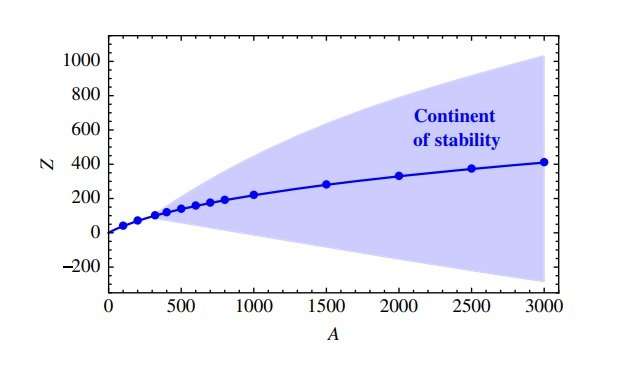June 15, 2018 feature
New form of matter may lie just beyond the periodic table

Currently, the heaviest element on the periodic table is oganesson, which has an atomic mass of 294 and was officially named in 2016. Like every element on the periodic table, nearly all of oganesson's mass comes from protons and neutrons (types of baryons) that are themselves made of three quarks each. A crucial feature of all known baryonic matter is that its quarks are bound together so tightly by the strong force that they are inseparable. As particles made of bound quarks (such as protons and neutrons) are called hadrons, scientists refer to the ground state of baryonic matter as "hadronic matter."
But oganesson may be one of the last of its kind. In a new paper, scientists predict that elements with masses greater than approximately 300 may be composed of freely flowing "up" and "down" quarks—the same kind that protons and neutrons are made of, but these quarks wouldn't be bound into triplets. The scientists predict that this type of matter, called "up down quark matter," or udQM, would be stable for extremely heavy elements that might exist just beyond the end of the current periodic table. If it could be produced on Earth, quark matter has the potential to be used as a new source of energy.
The possibility that heavy baryonic matter has a udQM ground state rather than a hadronic one is described in a paper published in Physical Review Letters by University of Toronto physicists Bob Holdom, Jing Ren, and Chen Zhang.
The idea that some kind of quark matter might form the ground state of baryonic matter is not new. In a famous paper from 1984, physicist Edward Witten suggested that strange quark matter (SQM) might fulfill this role. However, SQM consists of comparable amounts of up, down, and strange quarks. One of the new results of the latest study is that quark matter without strange quarks, i.e., udQM, has lower bulk energy per baryon than either SQM or hadronic matter, making it energetically favorable.
"Physicists have been searching for SQM for decades," the researchers told Phys.org. "From our results, many searches may have been looking in the wrong place. ... It is quite a basic question to answer: What is the lowest energy state of a sufficiently large number of quarks? We argue that the answer is not nuclear matter or strange SQM, but rather udQM, a state composed of nearly massless up and down quarks."
The idea that quark matter may lie just beyond the periodic table is somewhat surprising because, in general, quark matter is thought to exist only in extreme environments, such as the cores of neutron stars, heavy ion colliders, hypothetical quark stars, and within the first milliseconds of the early universe. When produced in a collider, quark matter typically decays within a fraction of a second into stable hadronic matter (with bound quarks).
The physicists hope that, if the minimum mass of elements with a udQM ground state is not much more than 300, it may be possible to produce this new form of stable matter by fusing together some of the other heavy elements. They expect that one of the challenges will be to supply enough neutrons in the reaction, but that udQM may be easier to produce than SQM. One reason for their optimism is that the new results point to the existence of a "continent of stability"—a large region in which udQM may have the most stable configuration, which may guide future production attempts.
If producing udQM presents difficulties, the researchers note that it can also be searched for on Earth, since it can arrive via cosmic rays and then become trapped in normal matter. In the future, the researchers plan to explore the possibility of searching for quark matter, both on Earth and in more distant locations.
"We would like to know more about the abundance of quark matter in the universe," the researchers said. "We are thus looking at the conversion rate of nuclear matter to udQM inside neutron stars. We would also like to identify those searches for SQM that are most relevant for udQM. It is then of interest to consider how those searches could be improved upon and/or extended."
If scientists could produce or find quark matter of any kind, one very intriguing potential application is energy generation.
"Knowing better where to look for udQM might then help to achieve an old idea, that of using quark matter as a new source of energy," the researchers said. "If quark matter is found (or produced in accelerators), it may be stored and then fed with slow neutrons or heavy ions. The absorption of these particles means a lower total mass and thus a release of energy, mostly in the form of gamma radiation. Unlike nuclear fusion, this is a process that should be easy to initiate and control."
More information: Bob Holdom, Jing Ren, and Chen Zhang. "Quark Matter May Not Be Strange." Physical Review Letters. DOI: 10.1103/PhysRevLett.120.222001 (open access)
Journal information: Physical Review Letters
© 2018 Phys.org





















